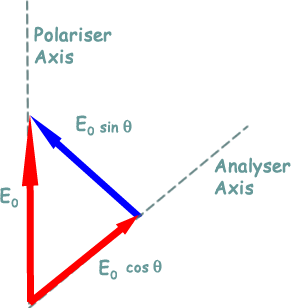Malus's Law Malus' law: It = Io cos2 θwhere θ is the angle between the polarization direction of the incident light and the transmission axis of the polarizer. ---------------------------------------------------------- When unpolarised light is passsed through a polarising filter its intensity is halved and only light parallel to the grid within the polarising filter is allowed through. The transmitted light then has the same axis of polarisation as the filter that polarised it. It is then perfectly plane polarised light. --------------------------------------- When perfectly plane polarized light is incident on an analyzer, the intensity It of the light transmitted by the analyzer is directly proportional to the square of the cosine of angle between the transmission axes of the analyzer and the polarizer.
i.e It ∝cos2θ
The analyzer can transmit only the component which is parallel to its transmission axis ( i.e E0 cos θ ) and the component E0sinθ will be absorbed by the analyser. Therefore, the intensity It of light transmitted by the analyzer is: It ∝ ( E0 x cos θ )2 It / I0 = ( E0 x cos θ )2 / E02 = cos2 θ so, It = I0 x cos2θ ∴ It ∝ cos2 θ.
Example QuestionUnpolarized light with an intensity of Io = 16 W/m2 is incident on a pair of polarisers.
Calculate the intensity of the light going through the pair of filters.
The light is unpolarized, so I1 = 1/2 Io = 8 W/m2.
When it emerges from the first polariser the light is linearly polarized at 50o. The angle between this and the transmission axis of the second polarizer is 50o- 20o= 30o Therefore: I2 = I1 cos2 30o = 8 x (0.866)2 = 8 x 0.75 = 6 W/m2
|
Follow me...
|






